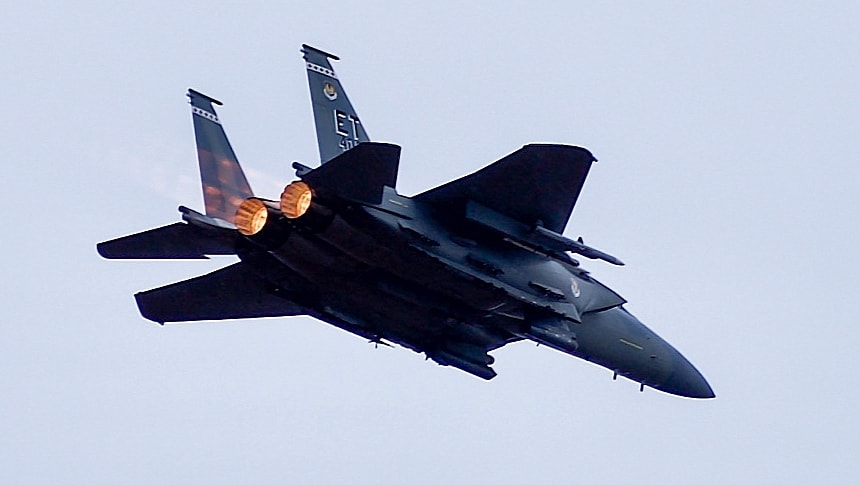The American F-15 aircraft family is one of the oldest of its kind in the skies of the world. Originally born in the early 1970s in the hangars of a company called McDonnell Douglas, it was repeatedly upgraded to keep up with the times and work on it won’t stop anytime soon.
That’s because in one of its more modern incarnations, the one known as the Eagle II, it was selected to be one of the five members of the future streamlined fleet of American fighter airplanes that will form the backbone of America’s airborne punch, alongside the F-35, F-16, A-10, and the upcoming sixth-gen Next Generation Air Dominance (NGAD).
For it to be able to do that, the plane is in need of serious upgrades, especially when it comes to its ability to defend itself from electronic and other kinds threats, or penetrate heavily protected by air defense systems.
To give the plane these capabilities the U.S. Air Force (USAF) has been testing for a while something called the EPAWSS. That’s short for Eagle Passive Active Warning Survivability System and it’s a technology being developed by British defense contractor BAE Systems.
We’ve heard things about the EPAWSS before, because the program has been ongoing since 2010, and actual testing began a decade later. The most recent piece of news about it surfaced during the Northern Edge 2023 (NE23) exercise held in Alaska last year. Back then, the system was seriously put through its paces, and it proved to work as advertised, with over 70 flight tests conducted.
The tech is technically a collection of multispectral sensors designed to give an aircraft a better understanding of its surroundings. On top of that, it feeds the pilot with radar warning, situational awareness, geolocation, and the ability to protect himself and the plane.
This latter part is owed to the fact that the EPAWSS also includes radio frequency electronic countermeasures. Unlike the technology currently in use, EPAWSS is smaller and all-digital and should give the veteran aircraft capabilities on par with what 5th-generation aircraft like the F-35 or F-22 have to offer.
This week BAE Systems announced the completion of the Initial Operational Test & Evaluation (IOT&E) of the system, meaning that EPAWSS is now validated for use in the aircraft in both the F-15E Strike Eagle and the F-15EX Eagle II aircraft.
For integration with the weapon platform the defense contractor is already working with the maker of the F-15, Boeing, but also with the USAF. Work is being conducted at the Nashua facility in New Hampshire and in Austin, Texas.
“The world’s most advanced EW systems,” as BAE Systems described its product, is currently in the low-rate production stage, and there is no word on when it will actually be deployed on a large scale.
For it to be able to do that, the plane is in need of serious upgrades, especially when it comes to its ability to defend itself from electronic and other kinds threats, or penetrate heavily protected by air defense systems.
To give the plane these capabilities the U.S. Air Force (USAF) has been testing for a while something called the EPAWSS. That’s short for Eagle Passive Active Warning Survivability System and it’s a technology being developed by British defense contractor BAE Systems.
We’ve heard things about the EPAWSS before, because the program has been ongoing since 2010, and actual testing began a decade later. The most recent piece of news about it surfaced during the Northern Edge 2023 (NE23) exercise held in Alaska last year. Back then, the system was seriously put through its paces, and it proved to work as advertised, with over 70 flight tests conducted.
The tech is technically a collection of multispectral sensors designed to give an aircraft a better understanding of its surroundings. On top of that, it feeds the pilot with radar warning, situational awareness, geolocation, and the ability to protect himself and the plane.
This latter part is owed to the fact that the EPAWSS also includes radio frequency electronic countermeasures. Unlike the technology currently in use, EPAWSS is smaller and all-digital and should give the veteran aircraft capabilities on par with what 5th-generation aircraft like the F-35 or F-22 have to offer.
This week BAE Systems announced the completion of the Initial Operational Test & Evaluation (IOT&E) of the system, meaning that EPAWSS is now validated for use in the aircraft in both the F-15E Strike Eagle and the F-15EX Eagle II aircraft.
For integration with the weapon platform the defense contractor is already working with the maker of the F-15, Boeing, but also with the USAF. Work is being conducted at the Nashua facility in New Hampshire and in Austin, Texas.
“The world’s most advanced EW systems,” as BAE Systems described its product, is currently in the low-rate production stage, and there is no word on when it will actually be deployed on a large scale.



















